Bhitarkanika, for those who do not know, is a RAMSAR site in Odisha in the Kendrapara district. Though its fame mainly lies in the fact that it has the highest nesting site for saltwater crocodiles, for us birders, it is more because it is a haven for birds which thrive in a mangrove estuarine habitat. Around 70 species of mangroves can be seen here. Bhitara means “interior”, while Kanika means beautiful, and it does live up to its name!
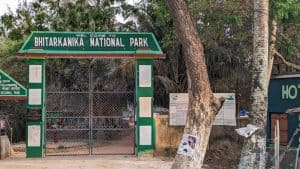
Coincidentally, this trip was planned in Pulicat, which has a similar estuarine habitat, while Mani sir and I took an American birder for birding. Since both of us have limited time, we discussed the possible trips we could take, which could be done over the weekend. After checking with my son’s school calendar, we found the Good Friday weekend was the best bet. So we locked into that date. Initially, we were thinking of combining Mangalajodi, too, but we realised we could not justify either hotspot as we had such a short time. Bhitarkanika had all our lifers, while Mangalajodi would have given us only some action shots, so Bhitarakanika won, hands down!
Now that we had fixed the dates and location, Mani sir sprung into action and caught hold of the guide and homestay for us 3 (Mani sir, Savitri mam and me). We booked with Bijay Kumar Das, who is the best guide for Bhitakanika and also happens to own the Mangrove Pitta homestay.
Day 1
As planned, we landed at Bhubaneshwar airport and went straight to Ekamra Kanan Park, where we wanted to see if we could see the pale-capped pigeon. I had already wrangled help from Swethashree, a fellow ebirder, to show us where we could likely see the pigeon. Unfortunately, we could not spot it as it is a crepuscular bird, and we were there only at around 9.30 am. I started off my lifer count for this trip with a bad photo of a brown-headed Barbet, though! We then decided to call it quits and went to have brunch and make our way to Bhitarkanika, which is about 160 km, approx 4hrs drive.
Search for the Fishing cat
The minute we landed in the homestay, we, as usual, started planning our sessions! It so happened that, that evening, three gentlemen were booked for a fishing cat trip. So we asked Bijay (our guide and homestay owner) whether we could join them as the boat was huge and could house around 12 people easily. Luckily for us, those gentlemen were cooperative and kind enough to let us join them! This had a dual advantage in that the boat cost got reduced, and we saved a session, too !
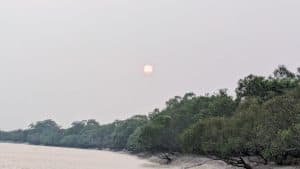
The creek in which we boat is a man-made creek with a number of jetties in between. Bhitarkanika national park entrance is the Dangamal Jetty. We started around 5.30 pm, and since the fishing cat is nocturnal, we cruised in the creek looking for birds, mammals, crocs, watermonitors etc, until the sun was down. We managed to see 3 of the 8 kingfishers that can be seen here, two of which were lifers for me! We just clicked record shots as Bijay assured us we would get better shots the following day when we do the dedicated bird trip for these.
Once the sun was down, we were plunged into total darkness; it was a bit scary but exhilarating, too, at the same time! The moon was in its gibbous phase and so rose a bit late. There we were, without even boat headlights (this is to avoid scaring away the cat), right in the water with swamps and mangroves on either side with salties moving back and forth between water and the banks and creating a splash!
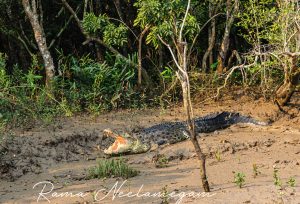
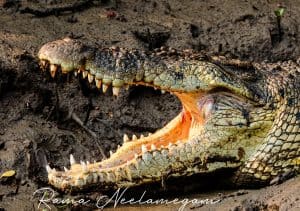
We started the cruise around 5.30pm and finished it at 11.45 pm. All this while we were in the water and saw about 4-5 fishing cats. Bijay had a knack for spotting them from their footprints and previous sighting places, etc. For me, more than the sighting was the boat ride, which was done in pitch dark and complete silence except for the boat motor. We did not have mobile signals in many places, so there were no pesky notification sounds either! We could see Pokhran Island and the Bay of Bengal, which were far away. The sky was so clear that I could see Orion Nebula with the naked eye! I gave a small tutorial to Mani sir on star gazing and identified a few stars and constellations for him.
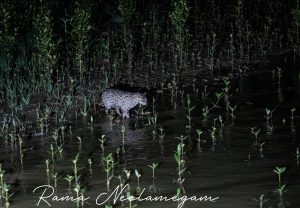
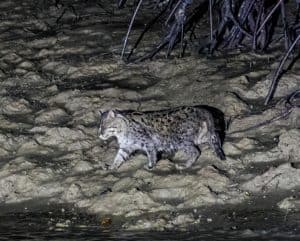
We concluded our trip with hearts and bladder full and stomach empty! Bijay brought the boat to a stop on a sand spit in the middle of nowhere. As the entrance to the park would be closed by this time, these guides have an alternate landing spot, especially for the night safaris where one can walk down to a few 100m to reach a track where a car can pick us up to transport us back to the homestay! Once I saw the spot where we had alighted, my immediate thought was that we were like some illegal immigrants crossing a border stealthily in the middle of nowhere in pitch dark with only a feeble mobile flashlight on a very narrow, muddy and slushy track with crocodile scare as they show in movies!!! This was a once-in-a-lifetime experience! The day ended with us seeing a resident Indian chameleon in the homestay!
Day 2
This day was dedicated to Kingfishers. Bhitarkanika is home to 8 KF ( black capped, Bronze winged, Stork billed, collared, Common, pied, white throated and sometimes ruddy) . The day started with Bijay showing us the beautiful chestnut capped babbler, yellow-bellied prinia, stork billed KF, etc. Once these were done, we drove down to the Khola Jetty, from where the boating for kingfishers started.
When we reached the slippery boat dock, we found that about 8 people were already there as Bijay had double booked. But since it was an open-air and a big boat, it didn’t make too much difference, and it did bring down the boat cost for us! We kick-started the trip with a green-faced malkoha- a super shy bird and moved on to spotting the kingfishers, which usually perched on the mangroves. Occasionally, we could spot a water monitor taking a stroll looking for insects and, of course, the Crocs!

We started at the Khola jetty and finished at the Dangmal end. As we were walking down the swampy trail, we saw Ashy Minivet, a greenish warbler, heard the pin-striped tit babbler and many more. The swamps were also abundantly filled with fiddler crabs, mudskippers, etc, apart from the all-pervading insects!
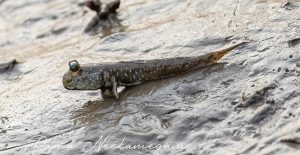
We walked through the mangrove trail and looked for the Mangrove Pitta, the flagship species of the National park. This sighting was ultimate because once we heard the bird call, we (about 8) were all scrambling to spot it. That place is super swampy, and Bijay warned us about quicksand. What was more annoying was the insects of all genera buzzing and swarming about our faces, hands and every inch of our exposed bodies. Luckily, Mani sir had come prepared with Odomos, which I liberally applied. This cut down the menace, but they were still relentlessly buzzing about our ears and nose! Right when I am about to click, one mosquito would get in my ear and go buzzzz and make me miss the frame!
By luck, I spotted the Pitta and alerted the group. The itsy bitsy bird also obliged and gave us a memorable sighting. Later in the day, we came back to spot the woodpeckers, the pinstriped tit babblers which had not given us a proper frame before. (This bird can be seen as a post)
Nocturnal birding looking for owls and nightjars
While the previous night was dedicated to the fishing cat, the second day was allotted for the owls and nightjars. We started just after sundown as Bijay’s son Biswajit told us that he was hearing calls of Oriental scops owl behind his house. Mani sir and I along, with 4 Pune birders followed Biswajit in pitch darkness with only our mobile lights and Biswajit’s torch for guidance. We had to walk only a few 100m behind his house, but that trek by itself was super spooky as we had to walk across a bund between two agricultural fields. Beyond the field to our left was a small waterbody where a small juvenile crocodile basking on the bund. It was practising fishing every now and then making abuge splash! At the end of the bund, there was a small, rickety crude bridge made with a coconut log and a few bamboo stumps as side support. The whole thing looked too flimsy and any slip will result in us stepping into slushy clayey marsh. We had to cross in that ultra carefully as it was very slippery too. Most of us crossed it safely except for one Pune birder who slipped and had got his pants dirtied with the slush.
Once the Oriental scops owl was done, our next target was the Collared scops owl, Indian scops owl and long tailed nightjar which was on the opposite side and a little farther away from the homestay. So we crossed the rickety old bridge (thankfully, all of us made it safe this time) , walked on the bund, keeping an eye on the crocodile and reached the road.
We then crossed the road and reached a track, where there was a liquor shop ( afcourse it was a full house!) and had to take another beaten track to go inside a woody area with marshes all around and mangrove roots sprouting all over the ground. Again we had to tread carefully on the bund, avoid the breathing roots, tree stumps and what not before we could reach the spot from where the owl was calling. From the call we realised it was collared scops owl and frantically took zillion shots as it was a lifer to all of us. Once that was done we went in search of the large tailed nightjar.
Though the bird was calling nonstop, we could not sight it as it was somewhere up on a canopy away from our line of sight. We then abandoned the search and went back for dinner. Biswajit promised us that we can try again post dinner. After dinner, everyone except me was not willing to try again. So only Biswajit and I went in pitch dark again in that marshy slushy woody track in search of the large tailed nightjar. Even though we did try for more than 30min we couldn’t sight it and I told Biswajit to abandon the search as I was kind of feeling scared being alone in that eerie place with my imagination running amok. I saw every log, rock and stick as either a crocodile or a snake!
Day 3
This was the last day of our trip and so we wanted to catch up with the birds that were still left out in the wish list. The primary one was the adjutant stork, an ugly looking stork which is often found in marshes, estauarine or near wetlands near agricultural fields *more about this bird is on a post). Bijay had a tip off that one was seen in a field nearby and we went in an auto looking for it. We eventually found it and most of our lifer list was done by then!
We then went back to the mangrove pitta trail so that Savitri mam could see the Pitta and Mani sir could take a better shot. Though we did see the Pitta and Mani sir took his shots, Savitri mam’s health again dint cooperate and she couldn’t see it once more! I managed to take some shots of the Pin striped tit babbler which I couldn’t take the day before. While Savitri mam went back in a vehicle Mani sir and I took the long trail to see if we could see any other birds. Inspite of trudging along in the hot sun we could not see many birds except the common ones and few water monitors! We then came back to homestay to pack and get ready for making our way to the airport back home!
This was one very very productive trip with 17 lifers and since we had shared the travel costs between three of us and the boat costs between many people our cost for the trip came down so dramatically !! This was one trip which gave value for money both in terms of both experience and lifers!!!!
The trip report can be seen in https://ebird.org/tripreport/231579